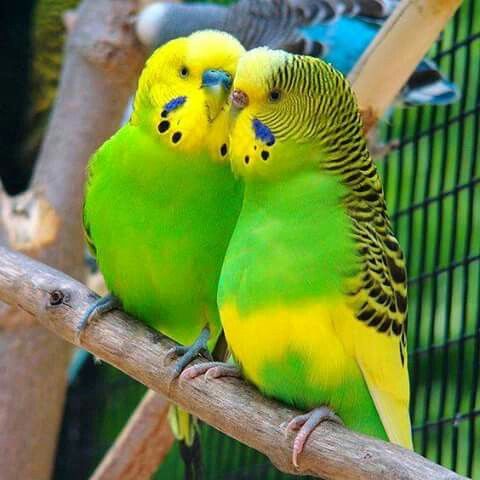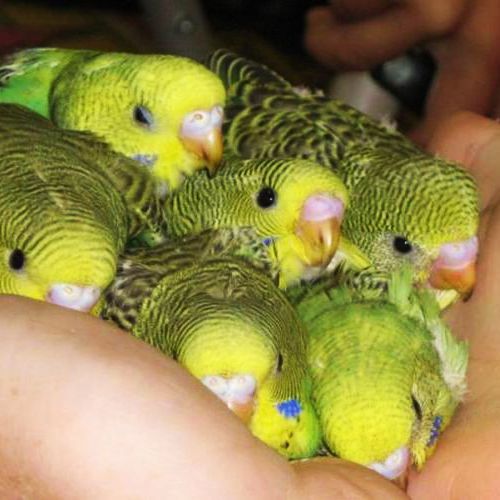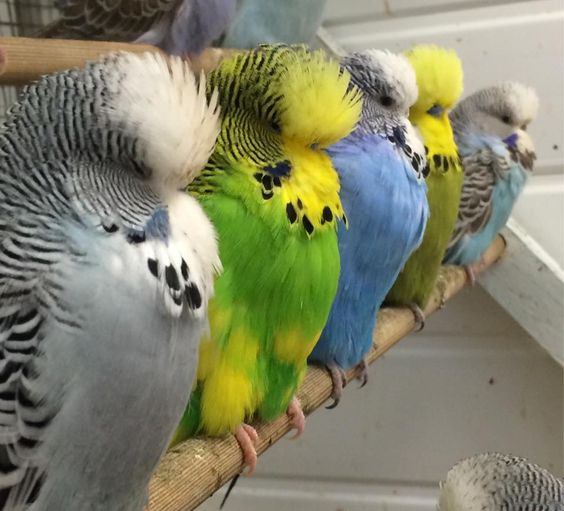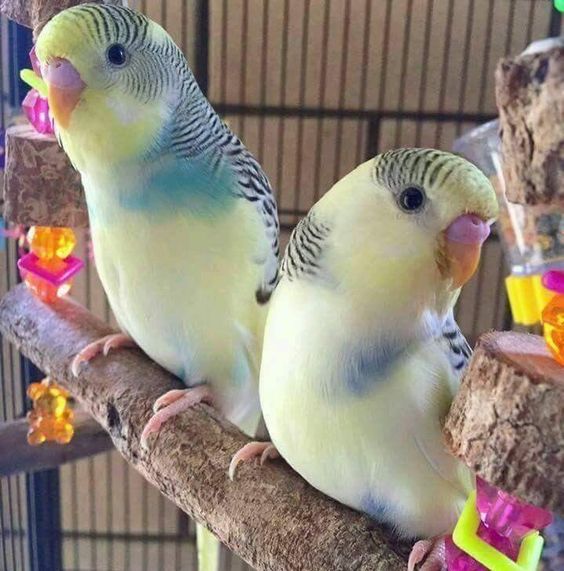Travel the world
Climb the mountains
Post Page Advertisement [Top]
The budgerigar (Melopsittacus undulatus) /ˈbʌdʒərɪɡɑːr/, also known as the common parakeet or shell parakeet and usually informally nicknamed the budgie, is a small, long-tailed, seed-eating parrot. Budgerigars are the only species in the Australian genus Melopsittacus and are found wild throughout the drier parts of Australia where the species has survived harsh inland conditions for the last five million years.Budgerigars are naturally green and yellow with black, scalloped markings on the nape, back and wings, but have been bred in captivity with colouring in blues, whites, yellows, greys and even with small crests. Budgerigars are popular pets around the world due to their small size, low cost and ability to mimic human speech. The origin of the budgerigar's name is unclear. The species was first recorded in 1805, and today is the third most popular pet in the world, after the domesticated dog and cat.
The budgerigar is closely related to the lories and the fig parrots.They are one of the parakeet species, a non-taxonomical term that refers to any of a number of small parrots with long, flat and tapered tails. In both captivity and the wild, budgerigars breed opportunistically and in pairs.
Breeding
Breeding in the wild generally takes place between June and September in northern Australia and between August and January in the south, although budgerigars are opportunistic breeders and respond to rains when grass seeds become most abundant.They show signs of affection to their flockmates by preening or feeding one another. Budgerigars feed one another by eating the seeds themselves, and then regurgitating it into their flockmate's mouth. Populations in some areas have increased as a result of increased water availability at farms. Nests are made in holes in trees, fence posts or logs lying on the ground; the four to six eggs are incubated for 18–21 days, with the young fledging about 30 days after hatching.
In the wild, virtually all parrot species require a hollow tree or a hollow log as a nest site. Because of this natural behaviour, budgerigars most easily breed in captivity when provided with a reasonable-sized nest box.
The eggs are typically one to two centimetres long and are pearl white without any colouration if fertile. Female budgerigars can lay eggs without a male partner, but these unfertilised eggs will not hatch. Females normally have a whitish tan cere; however, when the female is laying eggs, her cere turns a crusty brown colour. Certain female budgies may always keep a whitish tan cere or always keep a crusty brown cere regardless of breeding condition. A female budgerigar will lay her eggs on alternate days.After the first one, there is usually a two-day gap until the next. She will usually lay between four and eight eggs, which she will incubate (usually starting after laying her second or third) for about 21 days each.Females only leave their nests for very quick defecations, stretches and quick meals once they have begun incubating and are by then almost exclusively fed by their mate (usually at the nest's entrance). Females will not allow a male to enter the nest, unless he forces his way inside.Depending on the clutch size and the beginning of incubation, the age difference between the first and last hatchling can be anywhere from 9 to 16 days. At times, the parents may begin eating their own eggs due to feeling insecure in the nest box.
Sometimes, budgerigars (mainly males) are not interested in the opposite sex, and will not reproduce with them; a flock setting—several pairs housed where they can see and hear each other—is necessary to stimulate breeding.
Chick Health
Breeding difficulties arise for various reasons. Some chicks may die from diseases and attacks from adults. Other budgerigars (virtually always females) may fight over the nest box, attacking each other or a brood. Another problem may be the birds' beaks being under-lapped, where the lower mandible is above the upper mandible.
Most health issues and physical abnormalities in budgerigars are genetic. Care should be taken that birds used for breeding are active, healthy and unrelated. Budgerigars that are related or have fatty tumours or other potential genetic health problems should not be allowed to breed. Parasites (lice, mites, worms) and pathogens (bacteria, fungi and viruses), are contagious and thus transmitted between individuals through either direct or indirect contact. Nest boxes should be cleaned between uses.
Splay leg is a relatively common problem in baby budgerigars and other birds; one of the budgerigar's legs is bent outward, which prevents it from being able to stand properly and compete with the other chicks for food, and can also lead to difficulties in reproducing in adulthood. The condition is caused by young budgerigars slipping repeatedly on the floor of a nest box. It is easily avoided by placing a small quantity of a safe bedding or wood shavings in the bottom of the nest box. Alternatively, several pieces of paper may be placed in the box for the female to chew into bedding.
Development
Eggs take about 18–20 days before they start hatching. The hatchlings are altricial – blind, naked, unable to lift their head and totally helpless, and their mother feeds them and keeps them warm constantly. Around 10 days of age, the chicks' eyes will open, and they will start to develop feather down. The appearance of down occurs at the age for closed banding of the chicks. Budgerigars' closed band rings must be neither larger nor smaller than 4.0 to 4.2 mm.
They develop feathers around three weeks of age. (One can often easily note the colour mutation of the individual birds at this point.) At this stage of the chicks' development, the male usually has begun to enter the nest to help his female in caring and feeding the chicks. Some budgerigar females, however, totally forbid the male from entering the nest and thus take the full responsibility of rearing the chicks until they fledge.
Depending on the size of the clutch and most particularly in the case of single mothers, it may then be wise to transfer a portion of the hatchlings (or best of the fertile eggs) to another pair. The foster pair must already be in breeding mode and thus either at the laying or incubating stages, or already rearing hatchlings.
As the chicks develop and grow feathers, they are able to be left on their own for longer periods of time. By the fifth week, the chicks are strong enough that both parents will be comfortable in staying out of the nest more. The youngsters will stretch their wings to gain strength before they attempt to fly. They will also help defend the box from enemies, mostly with their loud screeching. Young budgerigars typically fledge (leave the nest) around their fifth week of age and are usually completely weaned between six and eight weeks old. However, the age for fledging, as well as weaning, can vary slightly depending on whether its age and the number of surviving chicks. Generally speaking, the oldest chick is the first to be weaned. Though it is logically the last one to be weaned, the youngest chick is often weaned at a younger age than its older sibling(s). This can be a result of mimicking the actions of older siblings. Lone surviving chicks are often weaned at the youngest possible age as a result of having their parents' full attention and care.
Hand-reared budgies may take slightly longer to wean than parent-raised chicks. Hand feeding is not routinely done with budgerigars, due to their small size and because young parent raised birds can be readily tamed.
Budgerigars and humans
Aviculture
The budgerigar has been bred in captivity since the 1850s. Breeders have worked to produce a variety of colour, pattern and feather mutations, including albino, blue, cinnamon-ino (lacewinged), clearwinged, crested, dark, greywinged, opaline, pieds, spangled, dilute (suffused) and violet.
"English budgerigars", more correctly called "show" or "exhibition budgerigars", are about twice as large as their wild counterparts and have puffier head feathers, giving them a boldly exaggerated look. The eyes and beak can be almost totally obscured by these fluffy head feathers. English budgerigars are typically more expensive than wild-type birds, and have a shorter life span of about seven to nine years. Breeders of English budgerigars show their birds at animal shows. Most captive budgerigars in the pet trade are more similar in size and body conformation to wild budgerigars.
Budgerigars are social animals and require stimulation in the shape of toys and interaction with humans or with other budgerigars. Budgerigars, and especially females, will chew material such as wood. When a budgerigar feels threatened, it will try to perch as high as possible and to bring its feathers close against its body in order to appear thinner.
Tame budgerigars can be taught to speak, whistle and play with humans. Both males and females sing and can learn to mimic sounds and words and do simple tricks, but singing and mimicry are more pronounced and better perfected in males. Females rarely learn to mimic more than a dozen words. Males can easily acquire vocabularies ranging from a few dozen to a hundred words. Pet males, especially those kept alone, are generally the best speakers.
Budgerigars will chew on anything they can find to keep their beaks trimmed. Mineral blocks (ideally enriched with iodine), cuttlebone and soft wooden pieces are suitable for this activity. Cuttlebones also supply calcium, essential for the proper forming of eggs and bone solidity. In captivity, budgerigars live an average of five to eight years, but life spans of 15–20 years have been reported.The life span depends on breed, lineage, and health, being highly influenced by exercise and diet. Budgerigars have been known to cause "bird fancier's lung" in sensitive people, a type of hypersensitivity pneumonitis.
Colour mutations
All captive budgerigars are divided into two basic series of colours; namely, white-based (blue, grey and white) and yellow-based (green, grey-green and yellow). Presently, at least 32 primary mutations (including violet) occur, enabling hundreds of possible secondary mutations (stable combined primary mutations) and colour varieties (unstable combined mutations).
Mimicry
Male specimens of budgerigars are considered to be one of the top five talking champions amongst parrot species, alongside the grey parrot, the amazon and the eclectus parrots, and the ring-necked parakeet.
Puck, a male budgerigar owned by American Camille Jordan, holds the world record for the largest vocabulary of any bird, at 1,728 words. Puck died in 1994, with the record first appearing in the 1995 edition of Guinness World Records.
In 2001, recordings of a budgerigar called Victor got some attention from the media. Victor's owner, Ryan B. Reynolds of Canada, stated Victor was able to engage in contextual conversation and predict the future.Though some believe the animal was able to predict his own death as was claimed,further study on the subject is difficult without the bird. The recordings still remain to be verified by scientific analysis.Critics argue Victor's speech in the recordings is not coherent enough to be determined as spoken in context.
Pet budgies have continued to make headlines all over the world for their mimicry, talking ability and charm. One budgie, named Disco, became an internet superstar.As of 2013, Disco had been viewed over 6,067,744 times on his YouTube channel.Some of Disco's most popular key phrases included, "I am not a crook" and "Nobody puts baby bird in a corner!".Disco died in 2017 due to an unknown illness.
In Popular Culture
Australian vernacular
Small bathing suits for men, commonly referred to as togs or "Speedos", are informally called "budgie smugglers" in Australia. The phrase is humorously based on the appearance of the tight-fitting cloth around the male's genitals looking like a small budgie. The phrase was officially added to the Oxford English Dictionary in 2016.
source: Wiki
Tags: Bird
, Pets and Pets
Subscribe to:
Post Comments (Atom)




















No comments:
Post a Comment